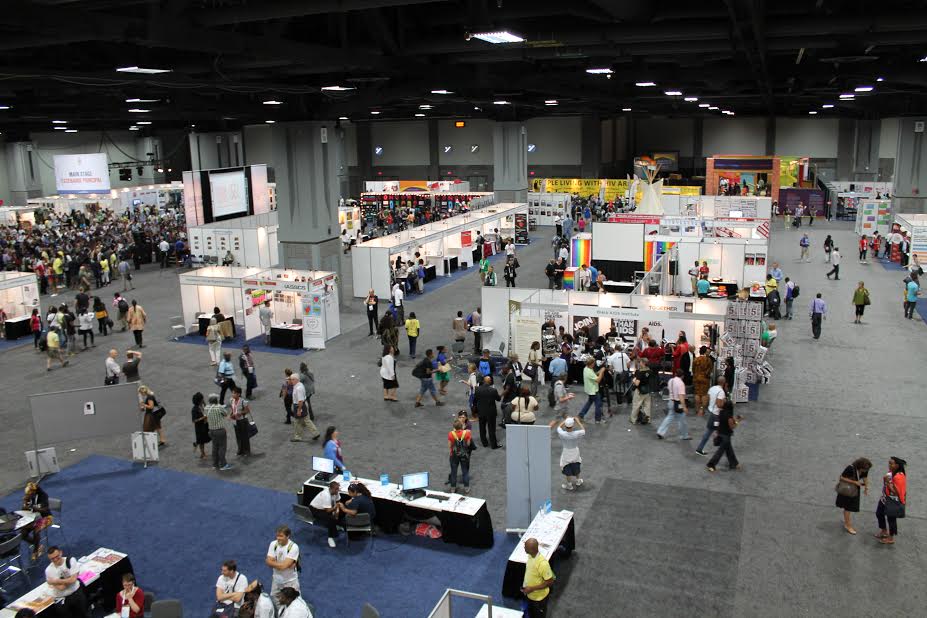By Clément Paule
Translation: Pierre Chabal
Passage au crible n°73
 Source : Wikipedia
Source : Wikipedia
From 22th to 27th July 2012, nearly 24,000 people from 183 countries participated in the 19th International Conference on AIDS (Acquired Immunodeficiency Syndrome) held in Washington by the IAS (International AIDS Society). This conference, held every two years since 1994, hosted many activities, whether scientific workshops, speeches by decision-makers or artistic events aimed at raising public awareness as to the HIV (Human Immunodeficiency Virus) / AIDS pandemic. The disease has caused 30 million deaths in three decades but the Summit was considered a success insofar as the possibility of ending the scourge in the near future was seriously envisaged. It seems clear that this relatively optimistic outlook –explicitly asserted by the slogan “Turning the tide together” – rely on essential technical breakthroughs while the financial crisis is leading to donor disengagement. Since then, calls for mobilization have succeeded one another in order to facilitate access to treatment for the 97% of patients living in low and middle-income countries while intensifying the efforts of medical research.
> Historical background
> Theoretical framework
> Analysis
> References
After the identification and isolation of the virus in the early eighties, many states implemented programs of public action designed to control the epidemic. Often criticized for their excluding or stigmatizing nature – thus, the quarantine procedures –, these local initiatives proved ineffective to contain the HIV/AIDS that turned into a pandemic during the decades that followed. Ultimately, the fight against this health disaster did take shape globally, as illustrated by the creation of institutional arrangements such as UNAIDS (Joint United Nations Programme on HIV / AIDS) in 1995. Meanwhile, there ahs been a multiplication of NGOs – such as Sidaction or AIDES in France – some of which manage to internationalize themselves, like ACT UP (AIDS Coalition to Unleash Power). For their part, states do not remain still and establish various cooperation mechanisms to reduce mortality in severely affected areas, especially in sub-Saharan Africa. As such, PEPFAR (President’s Emergency Fund for Aid Relief) created by George W. Bush in 2003 with several billion dollars, appears to be the largest government intervention in global health. In this logic, UNITAID was launched in 2006 to facilitate the purchase of medical treatments for developing countries from a solidarity tax on airline tickets implemented by thirty countries. Finally, we note the emergence of public-private structures such as the Global Fund to Fight against AIDS, Tuberculosis and Malaria set up as soon as 2002, a financial instrument in charge of centralizing and distributing funds dedicated to anti-HIV/AIDS activities.
Within this complex architecture, IAS was founded in 1988, with 16 000 members, including many researchers and health professionals specialising in the virus. This nonprofit organization has imposed itself as the holder of a leading multifaceted expertise: the recent appointment of Françoise Barré-Sinoussi – 2008 Nobel Prize for Medicine – as President of the organization bears testimony of the organisation’s prominence. As such, the IACs (International AIDS Conferences) play a crucial role insofar as they make it possible to render public the latest scientific discoveries about the disease, while boosting international mobilization and soliciting donors. Also, the choice of this forum to announce the possibility of halting the pandemic is very significant on a symbolic level, especially as this position is based on considerable technical advances. Let us mention here the patient in Berlin, presented as the first patient cured of AIDS after a bone-marrow transplant in 2007. It should also be noted that 34 million people now live with HIV but that only 54% of the 15 million people having developed the disease – about 8 million people – benefit from antiretroviral therapy. In addition, the UN estimates indicate that 2.7 million new infections would have occurred in 2010 – down 20% since 2001 – – while the number of deaths related to the virus is estimated at 1.8 million for the same period.
1. Global governance of health in action. This conference suggests a range of partnerships gathered around a given ‘global public concern’, namely the HIV / AIDS pandemic. But it is important to explore the lines of tension of the space that brings together actors with heterogeneous status and capital, which is not without an impact on the international management of the scourge.
2. Scientific advances Vs. socio-economic logics. If progress of research on the virus makes it now possible to consider its withering, most participants agree that a strictly technical approach is insufficient. In effect, the disease is deeply embedded into social relations on different scales, from the North-South gap to the moralizing stigmatisations.
The diversity of contributors to the event ought to be emphasised: alongside political figures – Secretary of State Hillary Clinton, former President Bill Clinton and South Africa’s Vice-President Kgalema Motlanthe – artists were present – Elton John – as well as international officials – the president of the World Bank Jim-Yong Kim, the UNAIDS Executive Director Michel Sidibé, businessmen as Bill Gates or renowned scientists. This multisectoral mobilization illustrates the gradual coexistence of state and interstate actors with the rise of non-state actors, including multinational corporations or private foundations. In this regard, let us mention the multipositionality of individuals such as former President Bill Clinton, who negotiated with pharmaceutical companies the reduction of the price of certain treatments. Yet, the growing role of philanthrocapitalists – like the Gates Foundation, which invested a total of 2.5 billion of dollars against HIV – and several States of the South is not enough to make up for the disengagement of donor countries in a context of austerity: UNAIDS estimates this loss at 7 billion of dollars for objectives three times more costly in 2015. Especially since Barack Obama, in fact absent from the conference, announced budget cuts for PEPFAR as soon as 2013.
Despite these difficulties, the research results are promising according to the Towards an HIV Cure initiative launched by the IAS, while health indicators seem to be improving. If a vaccine does not yet appear likely, new perspectives have been proposed to refine existing therapies, whose costs were lowered. Consider the case of Truvada, a prophylactic treatment which reduces the risk of transmission – up to 90% when taken daily, according to clinical studies – during a high-risk sexual intercourse, which was approved by the FDA (Food and Drug Administration) on the eve of the IAC. However, this latest innovation has aroused the concern of organizations like ACT-UP, which discussed the potential adverse effects of the medication in terms of prevention. More generally, the implementation of these techniques remains at the heart of controversies because the social logics in which the pandemic ascribes remain complex.
Thus, despite repeated denunciations of the stigmatization of people infected with the virus, many activists from the South failed to obtain a visa to go to Washington. The US administration in effect rejected visa applications from sex-workers, who then chose to organize simultaneously a counter-Summit in Kolkata, India. This parallel event called Sex Workers Freedom Festival brought together a thousand demonstrators, and gave itself the goal of claiming and obtaining the participation of these particularly vulnerable populations in decision-making for the fight against HIV/AIDS. This initiative was supported by the UNAIDS Executive Director, who recalled that less than 1% of international funding was devoted to sex workers while these were one of the groups most affected by the disease. In addition, protesters denounced the conditionalities attached to funds distributed through PEPFAR, which require the signature of an anti-prostitution clause by the organizations seeking financial support. This example shows, beyond the technical nature of the responses, the difficulty of ending a pandemic whose political dimension is proving omnipresent.
Dixneuf Marc, « La santé publique comme observatoire de la mondialisation », in : Josepha Laroche (Éd.), Mondialisation et gouvernance mondiale, Paris, PUF, 2003, pp. 213-225.
Website of the 19th International Aids Conference : http://www.aids2012.org [20 août 2012].
UNAIDS, UNAIDS Guidance Note on HIV and Sex Work, April 2012, to be accessed at : http://www.unaids.org [Aug.21th 2012].
UNAIDS, Together We Will End AIDS, July 18th 2012, to be accessed at : http://www.unaids.org [Aug. 25th 2012].




